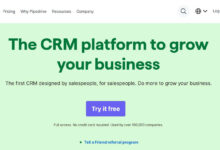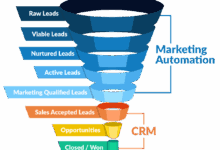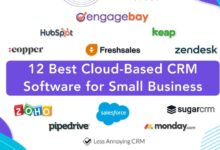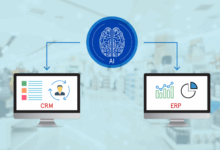CRM Software for Small Business Success
CRM Software for Small Business is more than just software; it’s a strategic investment in growth. Successfully managing customer relationships is crucial for any small business, regardless of size or industry. This guide explores how the right CRM system can streamline operations, boost sales, and foster lasting customer loyalty, addressing the unique challenges faced by businesses with limited resources and personnel.
From defining your specific needs and choosing the right platform to implementing best practices for data management and leveraging insightful analytics, we’ll cover everything you need to know to harness the power of CRM for your small business. We will examine different pricing models, essential features, and the integration capabilities that can truly transform how you interact with your customers and manage your business.
Defining Needs for Small Business CRM
Effective customer relationship management (CRM) is crucial for small businesses to thrive in today’s competitive landscape. A well-implemented CRM system can streamline operations, improve customer satisfaction, and ultimately boost profitability. However, choosing and utilizing the right CRM requires understanding the specific needs of your business.
Key Challenges in Small Business CRM
Small businesses often face unique challenges in managing customer relationships. Three key hurdles include: lack of centralized customer data, difficulty in tracking interactions and sales pipelines, and limited resources for sophisticated CRM solutions. These challenges can lead to missed opportunities, decreased efficiency, and ultimately, lost revenue.
Ideal CRM Features for Small Businesses
To overcome these challenges, a CRM system should offer several key features. A robust contact management system allowing for centralized storage and easy access to all customer information is essential. Sales pipeline management tools that provide a clear overview of sales progress and facilitate efficient follow-up are also crucial. Finally, reporting and analytics capabilities are needed to track key metrics and gain insights into customer behavior and sales performance. These features enable data-driven decision-making, fostering business growth.
CRM Needs Across Different Business Sizes
The ideal CRM system varies significantly depending on the size and structure of the small business. A solopreneur might only need a simple contact management system with basic task management capabilities. A five-employee team might require more advanced features like sales pipeline tracking and basic reporting. A twenty-employee team, on the other hand, might need a more comprehensive solution with features such as team collaboration tools, advanced reporting and analytics, and potentially integration with other business software. Scalability is a key consideration as the business grows.
Comparison of CRM Pricing Models
Choosing the right pricing model is vital for budget management. Here’s a comparison of three common models:
| Feature Set | Pricing | Pros | Cons |
|---|---|---|---|
| Basic contact management, limited features | Free (with limitations), or low monthly subscription | Low cost of entry, good for testing, easy to implement | Limited functionality, potential for hidden costs, may lack essential features for growth |
| Comprehensive features, scalable options, various integrations | Monthly or annual subscription, tiered pricing based on features and users | Flexibility, access to advanced features, usually includes support and updates | Ongoing cost, potential for subscription creep if needs change |
| All features upfront, one-time payment | Significant upfront cost | No recurring costs, ownership of the software | High initial investment, may require significant technical expertise, may not include updates or support |
Essential Features of CRM Software for Small Businesses
Choosing the right CRM system can significantly boost a small business’s efficiency and growth. A well-implemented CRM streamlines operations, improves customer relationships, and ultimately drives revenue. This section highlights five key features that offer the most impact.
Contact Management
Effective contact management is the cornerstone of any successful CRM strategy. It involves consolidating all customer information – contact details, communication history, purchase records, and interactions – into a centralized, easily accessible database. This eliminates the chaos of scattered spreadsheets and ensures everyone in the business has a consistent, up-to-date view of each customer. Improved access to comprehensive customer profiles enables personalized communication, targeted marketing campaigns, and proactive customer service, ultimately fostering stronger customer relationships and loyalty. For example, a small bakery using a CRM could track customer preferences (e.g., favorite pastries, dietary restrictions) to personalize offers and improve customer satisfaction.
Sales Pipeline Management
Sales pipeline management is the process of tracking leads and opportunities through the various stages of the sales cycle. A CRM system provides tools to visualize this pipeline, identify bottlenecks, and predict revenue. This allows small businesses to monitor progress, prioritize high-potential leads, and proactively address any issues that might hinder deal closure. For instance, a CRM could show a sales team that a particular stage in their sales process is consistently causing delays, allowing them to adjust their approach and improve efficiency. This feature provides valuable insights for forecasting sales and optimizing sales strategies.
Reporting and Analytics
CRM systems provide powerful reporting and analytics capabilities, offering valuable insights into customer behavior, sales performance, and marketing campaign effectiveness. This data-driven approach allows small businesses to make informed decisions, identify areas for improvement, and track progress toward their goals. By analyzing sales trends, for example, a small business can identify its most profitable products or services and adjust its marketing efforts accordingly. Detailed reports on customer interactions can also help identify customer service issues and areas for improvement.
Automation and Workflow
Automating repetitive tasks, such as sending follow-up emails or assigning leads, frees up valuable time for sales and marketing teams to focus on more strategic activities. A CRM system can automate these workflows, ensuring consistency and efficiency in customer interactions. For example, an automated email sequence could be set up to nurture leads and guide them through the sales funnel, improving conversion rates. This automation reduces the administrative burden and improves overall team productivity.
Integration with Other Business Tools
Seamless integration with other business tools, such as email marketing platforms, accounting software, and e-commerce platforms, is crucial for maximizing the value of a CRM system. This integration creates a unified view of customer data across all business functions, improving efficiency and reducing data silos. For instance, integrating a CRM with an email marketing platform allows for targeted email campaigns based on customer segmentation and purchase history, leading to improved marketing ROI. Similarly, integration with accounting software simplifies invoicing and payment processing, streamlining financial operations.
Choosing the Right CRM Platform
Selecting the ideal CRM for your small business can feel overwhelming, given the numerous options available. However, a methodical approach, focusing on your specific needs and a clear understanding of different platforms, will significantly streamline the process. This section will guide you through comparing popular options, making informed decisions, and asking the right questions of potential vendors.
Comparison of Three Popular CRM Platforms
Three popular CRM platforms frequently considered by small businesses are HubSpot, Zoho CRM, and Salesforce Essentials. Each offers a unique blend of features and pricing models. HubSpot, known for its robust inbound marketing tools, integrates seamlessly with its other marketing and sales applications. Zoho CRM provides a comprehensive, feature-rich platform at a competitive price point, particularly appealing to budget-conscious businesses. Salesforce Essentials, while part of the larger Salesforce ecosystem, offers a simplified, user-friendly interface tailored to the needs of smaller organizations. A direct comparison reveals significant differences in functionality, pricing, and scalability. HubSpot excels in marketing automation, Zoho offers broad functionality at a lower cost, and Salesforce Essentials provides a solid foundation within a larger, scalable platform.
Decision-Making Flowchart for CRM Selection
A well-structured flowchart can simplify the CRM selection process. The flowchart would begin by assessing the business’s size and budget. Based on these factors, it would branch to different CRM options. For example, a very small business with a limited budget might be directed towards a free or low-cost CRM like Zoho CRM, while a business with a larger budget and more complex needs might be guided towards HubSpot or Salesforce Essentials. The flowchart would then incorporate questions about specific feature requirements (e.g., marketing automation, customer support integration, reporting capabilities). Each “yes” or “no” answer would lead to different CRM recommendations or further questions, ultimately guiding the business owner towards the most suitable platform. The final stage would involve evaluating vendor support and contract terms.
Questions to Ask CRM Vendors
Before committing to a CRM purchase, small business owners should carefully consider several crucial aspects. A thorough understanding of the vendor’s support system, data security practices, and integration capabilities is paramount. Therefore, it’s crucial to ask questions concerning these aspects, allowing you to assess the suitability of the vendor for your long-term business needs. These questions can also reveal the vendor’s commitment to providing excellent customer service and resolving any potential technical issues. This thorough due diligence minimizes risks and maximizes the chances of selecting the right partner.
- What level of customer support do you offer, and what are the response times for different support channels?
- What security measures are in place to protect our customer data?
- What integrations are available with other software we currently use (e.g., accounting software, email marketing platforms)?
- What is your data backup and recovery process?
- What is the process for onboarding and training our team on the CRM?
Cloud-Based versus On-Premise CRM: Pros and Cons
The choice between cloud-based and on-premise CRM solutions significantly impacts cost, accessibility, and maintenance. Understanding the advantages and disadvantages of each is essential for making an informed decision. Cloud-based solutions offer flexibility and cost-effectiveness, while on-premise solutions provide greater control over data but require significant upfront investment and ongoing maintenance. The best choice depends on the specific needs and resources of the small business.
- Cloud-Based CRM: Pros
- Accessibility from anywhere with an internet connection.
- Lower upfront costs and predictable monthly subscriptions.
- Automatic updates and maintenance by the vendor.
- Scalability to adapt to growing business needs.
Cons
- Dependence on internet connectivity.
- Potential security concerns related to data stored off-site.
- Limited customization options compared to on-premise solutions.
- On-Premise CRM: Pros
- Greater control over data security and privacy.
- More customization options to tailor the CRM to specific business needs.
- No dependence on internet connectivity.
Cons
- High upfront investment in hardware and software.
- Ongoing costs for maintenance, updates, and IT support.
- Limited accessibility; users need to be on the company network.
Implementing and Using CRM Software Effectively
Successfully implementing a CRM system requires more than just purchasing the software; it demands a strategic approach to onboarding, data management, and leveraging analytical tools. A well-executed implementation translates to improved efficiency, better customer relationships, and ultimately, business growth. This section details the key steps involved in maximizing your CRM’s potential.
Employee Onboarding to a New CRM System
A structured onboarding process is crucial for ensuring employee adoption and proficiency with the new CRM system. This involves a phased approach, combining initial training with ongoing support. A poorly executed onboarding process can lead to user resistance and underutilization of the software’s capabilities.
- Initial Training: Begin with a comprehensive training session covering the system’s core functionalities, data entry procedures, and reporting features. Use a combination of presentations, hands-on exercises, and interactive tutorials tailored to different roles and responsibilities within the company.
- Role-Specific Training: Provide customized training materials addressing the specific needs and tasks of each employee role. Sales representatives, for instance, will require in-depth training on lead management and opportunity tracking, while customer service representatives will focus on case management and communication tools.
- Ongoing Support and Mentorship: Establish a system for ongoing support, including readily accessible documentation, FAQs, and dedicated support personnel. Pairing new users with experienced colleagues for mentorship can also accelerate the learning curve and provide practical guidance.
- Regular Check-ins and Feedback: Conduct regular check-ins with employees to assess their comfort level with the system and address any challenges they encounter. Gather feedback to identify areas for improvement in the training process and the system’s usability.
Best Practices for CRM Data Entry and Maintenance
Maintaining data accuracy and consistency is paramount for the success of any CRM system. Inaccurate or incomplete data renders the system useless, undermining its analytical capabilities and decision-making support. This requires establishing clear guidelines and procedures for data entry and regular data cleansing activities.
- Standardized Data Entry Procedures: Implement consistent data entry procedures across the organization. Define clear guidelines for data fields, formatting, and acceptable values to ensure uniformity and prevent inconsistencies.
- Data Validation Rules: Utilize data validation rules within the CRM system to automatically check for errors during data entry. This can prevent the entry of incorrect or incomplete information, reducing the need for manual correction.
- Regular Data Cleansing: Schedule regular data cleansing activities to identify and correct outdated, inaccurate, or duplicate information. This can involve removing inactive contacts, updating contact details, and merging duplicate records.
- Data Security and Access Control: Implement robust security measures to protect sensitive customer data. This includes access control mechanisms to restrict access to specific data based on user roles and responsibilities.
Maximizing CRM Reporting and Analytics Features
CRM systems provide powerful reporting and analytics tools that can offer valuable insights into business performance and customer behavior. Effectively utilizing these tools allows for data-driven decision-making and improved business outcomes.
Start by defining key performance indicators (KPIs) relevant to your business goals. These might include sales conversion rates, customer acquisition costs, customer lifetime value, or average deal size. The CRM system should then be configured to track and report on these KPIs. Regularly analyze the reports to identify trends, patterns, and areas for improvement. Utilize the system’s visualization tools to present the data in a clear and concise manner, facilitating better understanding and quicker decision-making. For example, a visual representation of sales pipeline progress, showing the number of leads at each stage, can help identify bottlenecks and areas needing attention. Similarly, analyzing customer churn rate can highlight potential issues with customer satisfaction and prompt proactive interventions.
Typical CRM Dashboard: Key Performance Indicators
Imagine a dashboard divided into several sections. The top section displays the most critical KPIs in large, easily readable numbers. This might include: “Total Revenue This Month: $X,” “New Customers This Week: Y,” and “Average Deal Size: $Z.” Below this, smaller charts and graphs visually represent trends over time. One chart could show monthly revenue growth, another could track the number of closed deals versus open opportunities, and a third might illustrate customer satisfaction scores. A final section might provide a quick overview of upcoming tasks and appointments, ensuring that critical deadlines are not missed. Each KPI is color-coded: green for exceeding targets, yellow for meeting targets, and red for falling short. This visual representation provides a quick, at-a-glance overview of the business’s health and performance.
CRM Software and Customer Service
Effective customer service is paramount for small businesses, directly impacting customer satisfaction, retention, and ultimately, profitability. A well-implemented CRM system significantly enhances a small business’s ability to provide exceptional customer service and build lasting relationships. By centralizing customer information and automating key processes, CRM streamlines interactions, improves response times, and fosters a more personalized customer experience.
CRM software enhances customer service interactions by providing a comprehensive view of each customer’s history. This includes past purchases, interactions, preferences, and any outstanding issues. This 360-degree view empowers customer service representatives to provide more informed and personalized support, leading to quicker resolution times and increased customer satisfaction. For example, a representative can instantly access a customer’s previous order details to address a query about a specific product or quickly identify recurring issues that may require proactive intervention.
Managing Customer Feedback and Resolving Issues
CRM systems offer robust tools for managing customer feedback. Feedback can be collected through various channels, including surveys, email, social media, and in-app feedback forms. This data is then centralized within the CRM, allowing businesses to track trends, identify areas for improvement, and measure the effectiveness of customer service initiatives. Furthermore, CRM systems often incorporate ticketing systems, which facilitate the efficient tracking and resolution of customer issues. Each issue is logged as a ticket, assigned to a representative, and tracked until resolution, ensuring that no customer query falls through the cracks. Reports and dashboards provide real-time visibility into the volume and nature of customer issues, enabling proactive identification and resolution of recurring problems.
Improving Customer Retention and Loyalty
By providing personalized and efficient service, CRM contributes directly to improved customer retention and loyalty. The ability to segment customers based on their preferences, purchase history, and interaction history allows for targeted marketing campaigns and personalized offers. For instance, a CRM system could identify customers who haven’t made a purchase in a while and automatically trigger a targeted email campaign offering a discount or special promotion. This proactive approach shows customers that the business values their loyalty and fosters stronger relationships. Similarly, CRM systems can help identify high-value customers and prioritize their service needs, ensuring they receive the best possible support. Analyzing customer data can reveal patterns in churn and provide insights into factors contributing to customer dissatisfaction, enabling the business to take proactive steps to improve retention. For example, identifying a pattern of customers leaving after experiencing long wait times on the phone can prompt improvements in staffing or call handling processes.
Automating Customer Service Processes
Automation features within CRM systems significantly streamline customer service processes, freeing up staff to focus on more complex issues. Automated email responses can acknowledge receipt of inquiries and provide initial guidance, while automated chatbots can handle frequently asked questions, freeing up human agents to handle more complex issues. Automated workflows can route inquiries to the appropriate departments or individuals based on predefined rules, ensuring efficient handling of customer requests. For instance, a CRM system can automatically assign a ticket to a specific technician based on the product or service mentioned in the customer’s query. Automated reminders can ensure that follow-up actions are taken, such as sending order confirmations or scheduling follow-up calls, improving the overall customer experience. This automation increases efficiency and allows for quicker response times, improving customer satisfaction and overall operational efficiency.
Final Review
Ultimately, selecting and effectively utilizing CRM software is a journey, not a destination. By carefully considering your specific business needs, choosing a platform that aligns with your goals, and committing to best practices in data management and utilization, small businesses can unlock significant growth potential. The key is to view CRM not merely as a tool, but as a strategic partner in building lasting customer relationships and driving sustainable success.





